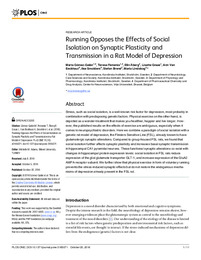Please use this identifier to cite or link to this item:
https://hdl.handle.net/11000/35430Full metadata record
| DC Field | Value | Language |
|---|---|---|
| dc.contributor.author | Gómez Galán, Marta | - |
| dc.contributor.author | Femenía Cantó, Teresa | - |
| dc.contributor.author | Aberg, Elin | - |
| dc.contributor.author | Grage, Lisette | - |
| dc.contributor.author | Van Eeckhaut, Ann | - |
| dc.contributor.author | Smolders, Ilse | - |
| dc.contributor.author | Brené, Stefan | - |
| dc.contributor.author | Lindskog, Maria | - |
| dc.contributor.other | Departamentos de la UMH::Farmacología, Pediatría y Química Orgánica | es_ES |
| dc.date.accessioned | 2025-01-28T18:44:10Z | - |
| dc.date.available | 2025-01-28T18:44:10Z | - |
| dc.identifier.citation | PLoS ONEO, 2016;11(10): e0165071 | es_ES |
| dc.identifier.issn | 1932-6203 | - |
| dc.identifier.uri | https://hdl.handle.net/11000/35430 | - |
| dc.description.abstract | Stress, such as social isolation, is a well-known risk factor for depression, most probably in combination with predisposing genetic factors. Physical exercise on the other hand, is depicted as a wonder-treatment that makes you healthier, happier and live longer. However, the published results on the effects of exercise are ambiguous, especially when it comes to neuropsychiatric disorders. Here we combine a paradigm of social isolation with a genetic rat model of depression, the Flinders Sensitive Line (FSL), already known to have glutamatergic synaptic alterations. Compared to group-housed FSL rats, we found that social isolation further affects synaptic plasticity and increases basal synaptic transmission in hippocampal CA1 pyramidal neurons. These functional synaptic alterations co-exist with changes in hippocampal protein expression levels: social isolation in FSL rats reduce expression of the glial glutamate transporter GLT-1, and increase expression of the GluA2 AMPA-receptor subunit. We further show that physical exercise in form of voluntary running prevents the stress-induced synaptic effects but do not restore the endogenous mechanisms of depression already present in the FSL rat. | es_ES |
| dc.format | application/pdf | es_ES |
| dc.format.extent | 11 | es_ES |
| dc.language.iso | eng | es_ES |
| dc.publisher | Public Library of Science | es_ES |
| dc.rights | info:eu-repo/semantics/openAccess | es_ES |
| dc.rights | Attribution-NonCommercial-NoDerivatives 4.0 Internacional | * |
| dc.rights.uri | http://creativecommons.org/licenses/by-nc-nd/4.0/ | * |
| dc.subject.other | CDU::6 - Ciencias aplicadas::61 - Medicina::615 - Farmacología. Terapéutica. Toxicología. Radiología | es_ES |
| dc.title | Running opposes the effects of social isolation on synaptic plasticity and transmission in a rat model of depression | es_ES |
| dc.type | info:eu-repo/semantics/article | es_ES |
| dc.relation.publisherversion | 10.1371/journal.pone.0165071 | es_ES |

View/Open:
Running Opposes the Effects of Social Isolation on Synaptic Plasticity and Transmission in a Rat Model of Depression.pdf
2,25 MB
Adobe PDF
Share:
.png)
